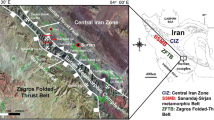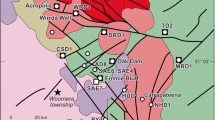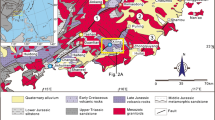Abstract
CO2-rich fluid inclusions containing opaque mineral crystals were found in the Fenghuangshan skarn-porphyry Cu–Fe–Au deposit in Tongling, Anhui, China. These inclusions show variable CO2 contents and are accompanied by aqueous inclusions, both occurring as secondary inclusions in quartz and being locally associated with chalcopyrite mineralization. Laser Raman microspectroscopic analyses confirm the predominance of CO2 in the vapor and the presence of H2S as high as 8 mol%, and identify the opaque mineral with yellow reflectance color in the inclusions as chalcopyrite. More than half of the CO2-bearing inclusions contains chalcopyrite, whereas few of the associated aqueous inclusions do so. The chalcopyrite, occupying less than 1% (volume) of the inclusions, is interpreted to be a daughter mineral, and calculated Cu concentrations in the inclusions range from 0.1 to 3.4 wt%. Copper is inferred to have been transported in CO2-dominated fluids as HS− complexes. The occurrence of chalcopyrite daughter crystals in CO2-rich fluid inclusions indicates that CO2-rich vapor has the capacity of transporting large amounts of Cu, and possibly Au. This finding has significant implications for metal transport and mineralization in hydrothermal systems enriched in CO2, such as orogenic-type and granitic intrusion-related gold deposits.




Similar content being viewed by others
References
Baker T (2002) Emplacement depth and carbon dioxide-rich fluid inclusions in intrusion-related gold deposits. Econ Geol 97:1111–1118
Barnes HL (1979) Solubility of ore minerals. In: Barnes HL (ed) Geochemistry of hydrothermal ore deposits. Wiley, pp 404–460
Brown PE (1989) FLINCOR: a microcomputer program for the reduction and investigation of fluid inclusion data. Am Mineral 74:1390–1393
Chang Y, Liu X, Wu Y (1991) The copper–iron belt of the lower and middle reaches of the Changjiang river. Geological Publishing House, Beijing, p 379 (in Chinese with English abstract)
Chi G, Williams-Jones AE, Dube B, Williamson K (2005) Carbonic vapor-dominated fluid systems in orogenic-type Au deposits. Geochim Cosmochim Acta 69:A738
Chi G, Dube B, Williamson K, Williams-Jones AE (2006) Formation of the Campbell–Red Lake gold deposit by H2O-poor, CO2-dominated fluids. Miner Depos 40:726–741
Drummond SE, Ohmoto H (1985) Chemical evolution and mineral deposition in boiling hydrothermal systems. Econ Geol 80:126–147
Hanley JJ, Mungall JE, Pettke T, Spooner ETC, Bray CJ (2005) Ore metal redistribution by hydrocarbon-brine and hydrocarbon-halide melt phases, North Range footwall of the Sudbury igneous complex, Ontario, Canada. Miner Depos 40:237–256
Heinrich CA, Günther D, Audétat A, Ulrich T, Frischknecht R (1999) Metal fractionation between magmatic brine and vapor, determined by microanalysis of fluid inclusions. Geology 27:755–758
Lowenstein JB (2001) Carbon dioxide in magmas and implications for hydrothermal systems. Miner Depos 36:490–502
Mountain BW, Seward TM (2003) Hydrosulfide/sulfide complexes of copper(I): experimental confirmation of the stoichiometry and stability of Cu(HS)2 to elevated temperatures. Geochim Cosmochim Acta 67:3005–3014
Pan Y, Dong P (1999) The lower Changjiang (Yangzi/Yangtze River) metallogenic belt, Eastern Central China: intrusion- and wall rock-hosted Cu–Fe–Au, Mo, Zn, Pb, Ag deposits. Ore Geol Rev 15:177–242
Ridley JR, Diamond LW (2000) Fluid chemistry of orogenic lode gold deposits and implications for genetic models. In: Hagemann SG, Brown PE (eds) Gold in 2000. Rev Econ Geol 13:146–162
Schmidt Mumm A, Oberthür T, Vetter U, Blenkinsop TG (1997) High CO2 content of fluid inclusions in gold mineralizations in the Ashanti Belt, Ghana: a new category of ore forming fluids? Miner Depos 32:107–118
Yang K, Scott SD (1996) Possible contribution of a metal-rich magmatic fluid to a sea-floor hydrothermal system. Nature 383:420–423
Williams-Jones AE, Heinrich CA (2005) Vapor transport of metals and the formation of magmatic-hydrothermal ore deposits. Econ Geol 100:1287–1312
Acknowledgements
This study is supported by the tenth national “Five-year Project” of China (Project Nos. 2001BA609A-06 and 2004BA615A-02) and by the Chinese Scholarship Council (to Lai). Petrographic and microthermometric studies were carried out at the Geofluids Laboratory in the University of Regina with support from CFI and NSERC (to Chi). Laser Raman spectrum analyses were carried out by Therese Lhomme at CREGU-UMR G2R, Nancy, France. We would like to thank S. Peng, Y. Shao, B. Yang, Z. Cao, and S. Li for their help in the field work. Dr. Kalin Kouzmanov is thanked for his constructive review, which improved the quality of the paper.
Author information
Authors and Affiliations
Corresponding author
Additional information
Editorial handling: L. Meinert
Rights and permissions
About this article
Cite this article
Lai, J., Chi, G. CO2-rich fluid inclusions with chalcopyrite daughter mineral from the Fenghuangshan Cu–Fe–Au deposit, China: implications for metal transport in vapor. Miner Deposita 42, 293–299 (2007). https://doi.org/10.1007/s00126-006-0109-z
Received:
Accepted:
Published:
Issue Date:
DOI: https://doi.org/10.1007/s00126-006-0109-z




